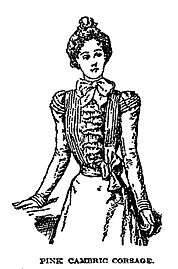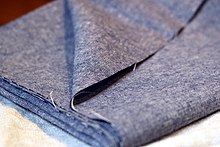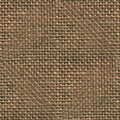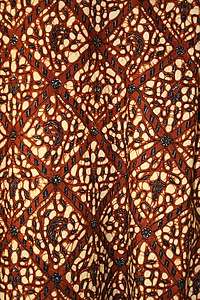Cambric
Cambric (US: /ˈkeɪmbrɪk/,[1] UK: /ˈkeɪmbrɪk/ or /ˈkæmbrɪk/),[2][3][4] or batiste, one of the finest and densest kinds of cloth,[5] is a lightweight plain-weave cloth, originally from the French commune of Cambrai, woven in greige, then bleached, piece-dyed and often glazed or calendered. Initially it was made of linen; later, the term came to be applied to cotton fabrics as well. Chambray is the same type of fabric,[6] with a coloured (often blue or grey) warp and white filling; the name "chambray" replaced "cambric" in the United States in the early 19th century.[7]

Cambric is used as fabric for linens, shirts, handkerchieves, ruffs,[8] lace, and needlework.[9]
Description

Cambric is a finely woven cloth with a plain weave and a smooth surface appearance, the result of the calendering process. It may be made of linen or cotton. The fabric may be dyed any of many colors.[10]
Batiste is a kind of cambric;[11] it is "of similar texture, but differently finished, and made of cotton as well as of linen".[12] Batiste also may be dyed or printed.[11] "Batiste" is the French word for "cambric" and some sources consider them to be the same,[10] but in English, they are two distinct fabrics.
Chambray, though the same type of fabric as cambric, has a coloured warp and a white weft, though it may be "made from any colour as you may wish, in the warp, and also in the filling; only have them differ from each other."[13]
Chambray differs from denim in that "chambray’s warp and weft threads will alternate one over the other, while denim’s warp thread will go over two threads in the weft before going under one."[14] As a result, the color of chambray cloth is similar front and back, while the reverse side of denim is lighter in color.[15]
The term "cambric cloth" also applies to a stiff, usually black, open-weave cloth typically used for a dust cover on the bottom of upholstered furniture.[16]
History
Cambric was originally a kind of fine, white, plain-weave linen cloth made at or near Cambrai.[12][11] The word comes from Kameryk or Kamerijk, the Flemish name of Cambrai,[12][11] which became part of France in 1677. The word is attested since 1530.[12] It is a synonym of the French word batiste,[12] itself attested since 1590.[17] Batiste itself comes from the Picard batiche, attested since 1401 and derived from the old French battre for bowing wool. The modern form batiste, or baptiste, comes from a popular merge with the surname Baptiste, pronounced Batisse, as indicated by the use of the expressions thoile batiche (1499) and toile de baptiste (1536) for the same fabric.[17] The alleged[18] invention of the fabric, around 1300, by a weaver called Baptiste or Jean-Baptiste Cambray or Chambray, from the village of Castaing in the peerage of Marcoing, near Cambrai, has no historic ground.[17][19][20][21] Cambric was a finer quality and more expensive[22] than lawn (from the French laune, initially a plain-weave linen fabric from the city of Laon in France[23]). Denoting a geographic origin from the city of Cambrai or its surroundings (Cambresis in French), cambric is an exact equivalent[24] of the French cambrésine (/kɑ̃.bʁe.zin/),[12] a very fine, almost sheer white linen plain-weave fabric,[25] to be distinguished[26] from cambrasine, a fabric comparable to the French lawn despite its foreign origin.[27] Cambric is also close to chambray (/ˈʃɒmbreɪ/ from a French regional variant of "Cambrai",[12] a name which "also comes from Cambrai, the French city, where the material was originally made of linen yarn".[28] Chambray (also spelled "chambrai") appears in North American English in the early 19th century.[12] Though the term generally refers to a cotton plain weave with a colored warp and a white weft, close to gingham, "silk chambray" seems to have coexisted.[29] Chambray was often produced during this period by the same weavers producing gingham.[30]
White linen cambric or batiste from Cambrai, noted for its weight and luster,[31] was "preferred for ecclesiastical wear, fine shirts, underwear, shirt frills, cravats, collars and cuffs, handkerchiefs, and infant wear".[32] Technical use sometime introduced a difference between cambric and batiste, the latter being of a lighter weight and a finer thread count.
In the 18th century, after the prohibition of imports into England of French cambrics,[33] with the development of the import of Indian cotton fabrics, similar[9] cotton fabrics, such as nainsook, from the Hindi nainsukh ("eyes' delight"),[12] became popular. These fabrics, initially called Scotch cambrics to distinguish them from the original French cambrics,[34] came to be referred to as cotton cambrics or batistes.[32] Some authors increased the confusion with the assumption the word batiste could come from the Indian fabric bastas.[35]
In the 19th century, the terms cambric and batiste gradually lost their association with linen, implying only different kind of fine plain-weave fabrics with a glossy finish.[36][37] In 1907, a fine cotton batiste had 100 ends per inch in the finished fabric, while a cheap-grade, less than 60.[38] At the same time, with development of an interest in coloured shirts, cambric was also woven in colours, such as the pink fabric used by Charvet for a corsage, reducing the difference between cambric and chambray. Moreover, the development and rationalization of mechanical weaving led to the replacement, for chambray, of coloured warp and white weft by the opposite, white warp and coloured weft, which allowed for longer warps.[39]
In popular culture
The English folk song ballad "Scarborough Fair" has the lyric in the second verse "Tell her to make me a cambric shirt, / Parsley, sage, rosemary, and thyme / Sewn without seams or fine needlework, / Then she'll be a true love of mine." It also appears in the David Bowie song, "Come And Buy My Toys" in the lyrics "You shall own a cambric shirt, you shall work your father's land." In the Andrzej Sapkowski Witcher novel, The Last Wish, Renfri described her privileged upbringing, referring to "...dresses, shoes. Cambric knickers. Jewels and trinkets..." as if suggesting that the cambric material was an indication of the fabric's high quality.
In Agatha Christie's novel Murder on the Orient Express, a cambric handkerchief with an H monogram is one of the clues in the murder.
References
- "Cambric". Merriam Webster.
- Longman Dictionary of Contemporary English
- Definition of "cambric" at Collins Dictionary
- Definition of "cambric" at Oxford Dictionaries
- Sir David Brewster (1814). Second American edition of the new Edinburgh encyclopædia. Published by Samuel Whiting and John L. Tiffany [and others]. pp. 189–190.
- Extension of the Emergency Price Control Act of 1942. U.S. Government Printing Office. 1944. p. 823. Retrieved 14 July 2020.
- Bradley, Linda Arthur (2014). Ethnic Dress in the United States. Rowman & Littlefield Publishers. pp. 67–68. ISBN 9780759121508.
- Westman, Hab'k O. (1844). Transactions of the Society of Literary & Scientific Chiffoniers. New York: Harper & Brothers. p. 58.
- Elisabeth Hardouin-Fugier; Bernard Berthod; Martine Chavent-Fusaro (1994). Les étoffes: dictionnaire historique (in French). Editions de l'amateur. p. 120.
- Mytum, Harold, ed. (2018). Death Across Oceans: Archaeology of Coffins and Vaults in Britain, America, and Australia. Smithsonian.
- Chisholm, Hugh, ed. (1911). . Encyclopædia Britannica (11th ed.). Cambridge University Press.
- Oxford English Dictionary
- Bronson, J. and R. (1977) [First published in 1817]. Early American Weaving and Dyeing: The Domestic Manufacturer's Assistant and Family Directory in the Arts of Weaving and Dyeing. New York: Dover Publications. p. 21.
- "WHAT'S THE DIFFERENCE BETWEEN CHAMBRAY AND DENIM?". Nenad SEO.
- "Chambray vs Denim". Proper Cloth. Retrieved 4 August 2018.
- "Cambric (Dustcover) - DIY Upholstery Supply". www.diyupholsterysupply.com. Retrieved 10 April 2018.
- Le Robert: Dictionnaire historique de la langue française (in French). 1. Dictionnaires Le Robert. 2000. p. 352. ISBN 2-85036-532-7.
- Archives historiques et littéraires du nord de la France, et du midi de la Belgique (in French). Au Bureau des Archives. 1829. pp. 341–.
- France. Comité des travaux historiques et scientifiques. Section d'histoire et de philologie (1898). Bulletin historique et philologique du Comité des travaux historiques et scientifiques (in French). Impr. nationale.
Pas plus une réalité historique que l'étymologique brasseur Cambrinus.
- Société d'émulation de Cambrai (1859). Séance publique [afterw.] Mémoires (in French). pp. 1–.
On ignore complètement le siècle où a vécu Jean-Baptiste Cambrai.
- Max Pfister (1980). Einführung in die romanische Etymologie (in German). Wissenschaftliche Buchgesellschaft, [Abt. Verl.] ISBN 978-3-534-07834-9.
Obschon Cambrai fûr die mittelalterliche Leinenindustrie bekannt ist und Baptiste sogar mit einem Denkmal geehrt wurde, dürfte dieser Fabrikant historisch nicht nachweisbar sein, da batiste etymologisch auf battre zurück geht.
- Belfast Literary Society (1808). Select papers. p. 32.
Cloth of this fabrick, lower than 5s. per yard, is called Lawn, above 5s., Cambrick.
- Société des amis de la Romania (1900). Romania. 29. Société des amis de la Romania. p. 182.
- Revue de l'enseignement des langues vivantes (in French). 1902. p. 304.
- Bernardini, Michele (2004). "The Illustrations of a Manuscript of the Travel Account of François de la Boullaye le Gouz in the Library of the Accademia Nazionale dei Lincei in Rome". Muqarnas. 21: 64. doi:10.1163/22118993-90000054.
Elle a une pièce de cambrésine sur son corps tellement fine que l'on voit à travers.
- Académie française (1836). Dictionnaire de l'Académie française (in French). Firmin Didot frères. p. 135.
- Guillaumin (Gilbert-Urbain, M.) (1839). Dictionnaire universel théorique et practique du commerce et de la navigation (in French). Guillaumin et Cie. p. 493.
On a donné ce nom à des toiles fines d'Egypte, à cause de leur ressemblance avec la toile de Cambrai. Il y a aussi des cambrasines, que l'on tire de Smyrne; elles sont de deux sortes : celles qui viennent de la Perse, et celles apportées de la Mecque. Les premières conservent la dénomination de cambrasinbes; les secondes se nomment mamoudis.
- Eliza Bailey Thompson (1917). The cotton and linen departments. Ronald press company. p. 63.
- Bassett, Lynne Z. (2001). Textiles for Regency clothing 1800-1850: a workbook of swatches and information. Q Graphics Production Co. p. 28.
- Fowler Mohanty, Gail (Summer 1989). "Putting up with Putting-Out: Power-Loom Diffusion and Outwork for Rhode Island Mills, 1821-1829". Journal of the Early Republic. 9. pp. 204, 206, 214.
- Savary des Bruslons, Jacques (1741). Dictionnaire universel de commerce (in French). 1. Paris: Vve Estienne. p. 902.
Sorte de toile de lin, très fine, & très blanche
- Greene, Susan W. (2005). Encyclopedia of Clothing and Fashion. 1. Charles Scribner's sons. p. 217.
- The Gentleman's magazine. F. Jefferies. 1759. p. 241.
- Official descriptive and illustrated catalogue: Great Exhibition of the Works of Industry of all Nations, 1851. By Authority of the Royal Commission. In 3 volumes. Spicer Brothers. 1851. p. 516.
- George Ripley; Charles Anderson Dana (1859). The new American cyclopaedia: a popular dictionary of general knowledge. D. Appleton and Co. pp. 738–.
- Denny, Grace Goldena (1923). Fabrics and How to Know Them. Lippincott. OCLC 2231068.
In this century, [nainsook] is described as a soft-finished white cotton fabric with a polish on one side ... not so closely woven as cambric but heavier than batiste.
- Philippine magazine. 1922. p. 382.
Cambric is a fine calendered cotton or linen cloth of plain weave characterised by the smooth glossy surface.
- Frank P. Bennett & Co (1914). A cotton fabrics glossary. Frank P. Bennett & co., inc. p. 125.
- David Page Coffin (1998). Shirtmaking: developing skills for fine sewing. Taunton Press. p. 7. ISBN 978-1-56158-264-8.
External links
| Wikimedia Commons has media related to Cambric. |


.svg.png)